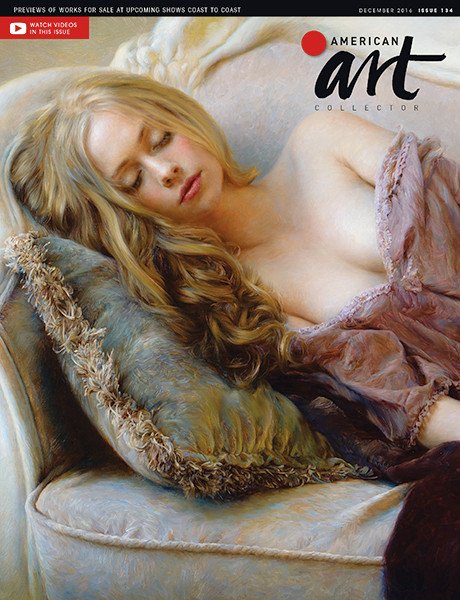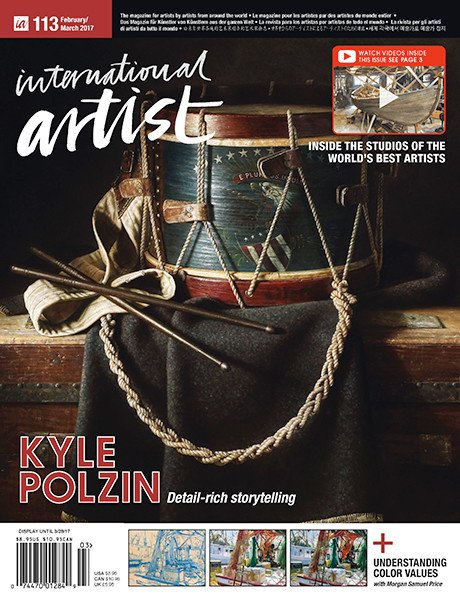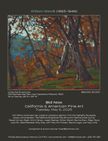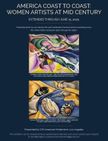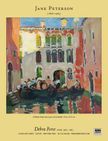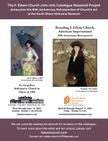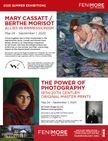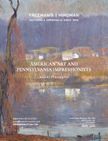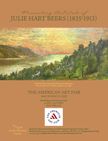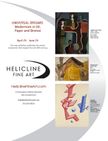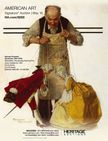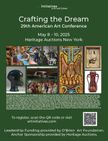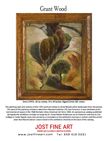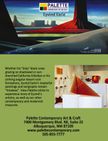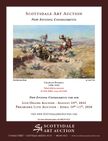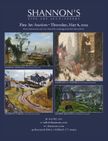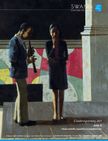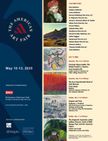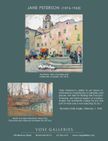Artists in the early-to-mid 20th century responded in two distinct ways to the rapid industrialization and tumultuous changes in the world around them. Some turned to realism. Others took to abstraction. Work created by artists in both camps is categorized as modernist, one reason that the genre is so difficult to define. There is no aesthetic cohesiveness and its beginnings, and more so its end, is nebulous at best—troubling to a culture that likes to dice up history into easily digestible, linear bites.

Whitney Museum of Art, Space Motive, a New Jersey Valley, 1913-1914. Oil on linen, 301/8 x 401/8 in., by Oscar Bluemner, Whitney Museum of American Art, New York; purchase, with funds from Mrs. Muriel D. Palitz 78.2.
What we can say is that American modernism was a reflection of American life in the 20th century, which is why the artwork that defines the movement is as diverse as the artists’ experiences who created it.
Jacob Lawrence expressed the spirit of contemporary life during the Harlem Renaissance. Thomas Hart Benton painted Midwestern scenes of farms and factories; while Edward Hopper was capturing the anxiety and isolation of post-war America in easily-relatable realism.
In the Southwest, the Transcendental Painting Group, led by Raymond Jonson and Emil Bisttram, was visually exploring spiritual realms through otherworldly abstractions. Of course, all of these artists’ styles evolved over time, some more extremely than others, with realism giving way to abstraction, and soft lines hardening into the geometric; and in some cases, in the reverse.
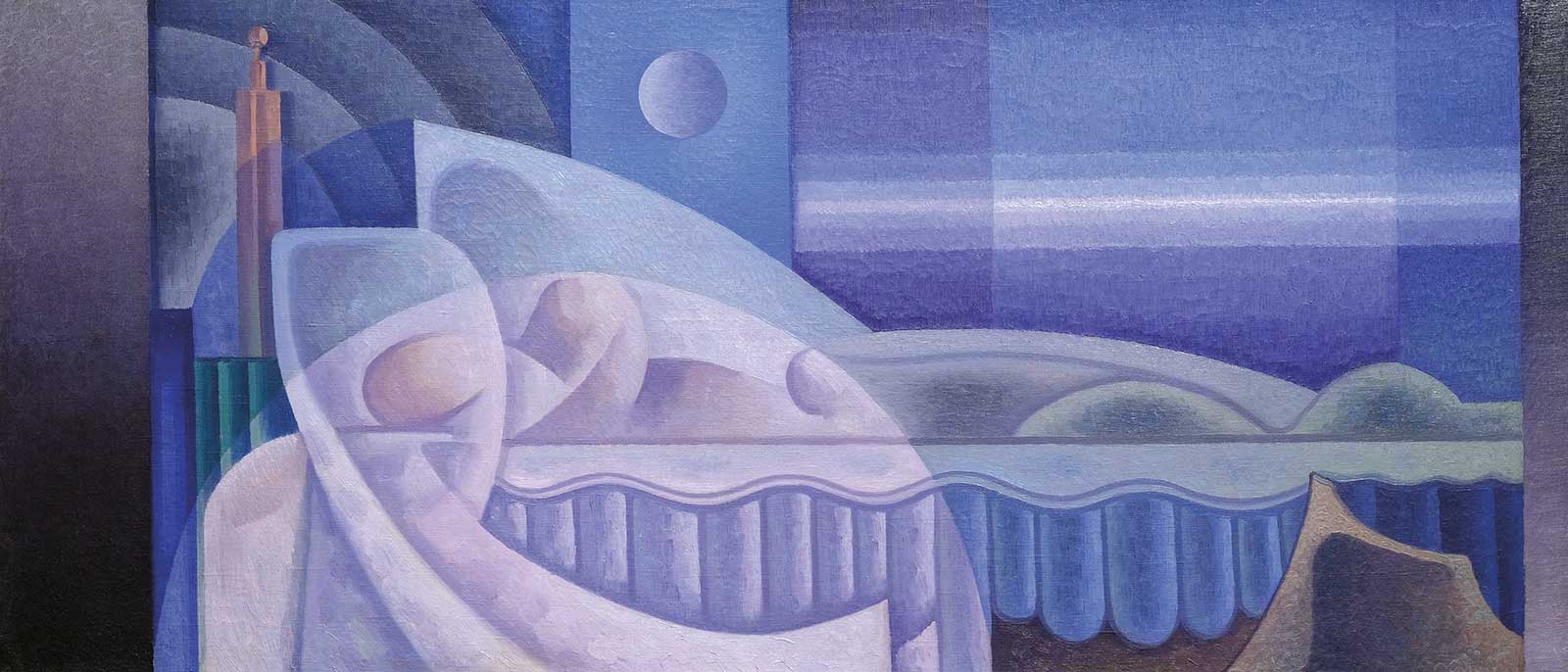
Addison Rowe Gallery, Composition Eight, Repose, 1929. Oil on canvas, 25 x 50 in., signed and dated lower right, by Raymond Jonson (1891-1982).
Oscar Bluemner’s Space Motive, a New Jersey Valley, 1913-1914, depicts houses along a winding waterway. Bluemner abstracted the highly stylized landscape by manipulating perspective and his application of broad blocky strokes and shapes. The German-born artist arrived in the United States in 1892 and by 1908, he had joined the circle of modernist painters affiliated with Alfred Stieglitz’s 291 gallery. “Like others in this group, Bluemner rejected illusionistic realism in favor of art that communicated emotions,” notes the Whitney Museum of Art. “For him, the key was color…layering arabesques and rounded forms and creating glossy, jewel-like surfaces that resembled lacquered ones.”
A few years after Bluemner painted Space Motive, a New Jersey Valley, Georgia O’Keeffe painted Evening Star, No. III, 1917, another color-driven piece with a vastly different outcome. “The evening star would be high in the sunset sky when it was still broad daylight,” said O’Keeffe, recalling her time in Texas. “That evening star fascinated me.” The Museum of Modern Art elaborates: “In this sequence of watercolors, she merges subject, material and technique to trace the progression of a sunset: from an all over expanse of wet-on-wet color to distinct bands of pigment separated by passages of paper to fuzzy dissolution.”

Debra Force Fine Art, Mecklenburg Evening, 1980. Collage with oil, paper, fabric, foil, pencil and watercolor on paper laid down on Masonite, 14 x 18 in., by Romare Bearden (1911-1988).
O’Keeffe and Bluemner were friends. Although O’Keeffe’s visual legacy is largely an ode to her beloved New Mexico; and Bluemner’s to his New Jersey—and many differences can be pointed out between them—both artists distilled their respective environments into a modernist language to best capture the essence of place.
In the remainder of this annual special section, leading fine art galleries and museums showcase a wide range of modernist works in their collections that highlight the breadth of this dynamic movement in American art history, followed by features relating to the genre and insight by top scholars who specialize in it.

A.J. Kollar Fine Paintings, White Walls, 1959. Oil on canvas, 9 x 12 in., signed lower right, titled and dated on reverse, by Stuart Davis (1894-1964).

Addison Rowe Gallery, Rising Figuration, 1935. Oil on board, 35¼ x 27½ in., signed and dated lower left, by Raymond Jonson (1891-1982).

CW American Modernism, Reversible Composition, ca. 1937. Oil on composition board, signed verso in pencil, 12 x 15 / 15 x 12 in., by Charles Walther (1879-1937).
Addison Rowe Gallery is a leader in the field of American art. Based in Santa Fe, New Mexico, the gallery exhibits important works by American and Southwest Modernists, the Stieglitz Circle, Taos Society of Artists, New York Geometric Abstract painters and the women of Abstract Expressionism. The gallery has been the exclusive representative of the Raymond Jonson estate for the last 12 years. It has a long history of promoting the work of the artists from the Transcendental Painting Group which was established in Santa Fe in 1938 by Jonson and Emil Bisttram. Gallery founder Victoria Addison Rowe helped curate and promote the exhibition, Another World: The Transcendental Painting Group, which traveled to five museums over a two-year period. Rowe’s career in the art business has taken her from New York to Chicago and finally Santa Fe, where she opened the gallery in 2006. She has been an active member of the art community since.
For over 40 years, A.J. Kollar Fine Paintings has specialized in American paintings from the 19th and early 20th centuries. Their selection process is refined, focusing on works of compositional integrity, historical significance and quality condition. They purchase and sell fine art outright in addition to accepting works on consignment. Located in Seattle, Washington, A.J. Kollar Fine Paintings works with private collectors across the country whether they want to purchase a single work, build a complete collection or sell paintings from their collection. They value the scholarship and preservation of American paintings in sustaining American art history.

CW American Modernism, Sun Image/God, 1936. Oil on canvas, signed lower right, 30 x 24 in., by Jerre Murry (1904-1973).

Debra Force Fine Art, Flowers and Pot, 1911. Watercolor on paper laid down on board 16¾ x 1315/16 in., by John Marin (1870-1953).

Museum of Modern Art, Evening Star, No. III, 1917. Watercolor on paper mounted on board. 87/8 x 117/8 in. by Georgia O’Keeffe. The Museum of Modern Art, New York. Mr. and Mrs. Donald B. Straus Fund. © 2012. The Georgia O’Keeffe Foundation / Artists Rights Society (ARS), New York. Digital Image © The Museum of Modern Art, New York, Digital Imaging Studio.
This month’s cover comes from CW American Modernism, a private gallery specializing in 20th-century American art with a focus on the period between 1910 and 1960. The gallery believes in the importance and relevance of this art and the people who created it. Whether made by artists who are well-known or barely known, gallery owner Chris Walther looks for works that are compelling and speak to the times and places where they were created, and to the present. He is fascinated by the just recently, but irretrievably, lost past and how paintings, sculpture and other material culture can inform our understanding of the broader historical context. He says, “Sometimes challenging, often beautiful, but hopefully always intriguing, we offer works that are attainable by beginning collectors and works that appeal to seasoned veterans as well.”
Debra Force Fine Art exhibits works by American modernist and post-war artists dating from the early 1900s through the late 20th century. Beginning with artists who were introduced to cubism and fauvism while studying in Europe, to those influenced by the 1913 Armory Show, the early modernists were supported by Alfred Stieglitz, Charles Daniel, and later, Edith Halpert. Abstract art further developed with the founding of the American Abstract Artists Group in the 1930s and growth of Abstract Expressionism in the following decade. Concurrently, the precisionists, magic realists, and artists like Milton Avery and Fairfield Porter, continued to paint in a representational manner. The gallery’s featured piece, Flowers and Pot, was exhibited by John Marin at Stieglitz’s Gallery 291 during the summer of 1911 at the onset of the modernist movement, while Romare Bearden’s complex collage, Mecklenburg Evening, dates from 1980 and reflects the artist’s interest in portraying personal and universal issues as well as his own experiences at the latter half of the century.

Helicline Fine Art, Cityscape, 1930. Oil on canvas, 36 x 30 in., signed and dated lower right, by Ernest Fiene (1894-1965).

Helicline Fine Art, Abstract Construction #2, 1936. Caesin on board collage, 11 x 13½ in., signed and dated upper right and titled on reverse, by Vaclav Vytacil (1892-1984).

J. Kenneth Fine Art, Fisherman, Provincetown, 1961. Watercolor on paper, 12¼ x 9¼ in., by Lester Johnson (1919-2010).
Founded in 2008, Helicline Fine Art specializes in American and European modernism, with a particular focus on the transformative art movements of the 20th century. At the heart of the gallery’s offerings are works from the 1930s and 1940s Works Progress Administration (WPA) period—a time when art served as both a reflection of and a response to societal change. In addition, Helicline showcases American Scene painting, social realism, mural studies, industrial landscapes, regionalism, abstraction and outsider art, among other compelling genres. Proprietors Keith Sherman and Roy Goldberg are collectors turned dealers, driven by an insatiable passion for discovery and storytelling through art. “We collect, acquire and sell artwork with passion,” says Sherman. “We are obsessed, in the most wonderful ways, with connecting collectors, curators and institutions to works that inspire and endure.”
J. Kenneth Fine Art has remained committed to a well-curated group of artists and estates within the secondary and blue-chip markets with an emphasis on the contributions of post-war artists who had been overlooked. In particular, JKFA has consistently highlighted female abstract painters of the mid-century, well before the current resurgence of interest in their work by collectors, auction houses and museums, including Lynne Mapp Drexler, whose estate he represented from 2015 to 2021. Since moving the gallery to historic Shelburne, Vermont, in the spring of 2024, JKFA has expanded its collection to include turn of the century, depression-era and mid-century paintings of Vermont by a variety of historically significant artists.

J. Kenneth Fine Art, Pompeii #1, ca.1949. Color woodcut on paper, 12 x 18 in., by Frank Wallace (1915-2003).

Palette Contemporary Art and Craft, Rolling Hills, 1964. Acrylic on panel, 18 x 33 in. (framed), by Earle Eyvind (1916-2000).

Palette Contemporary Art and Craft, Color Rectangles, 1995. Silkscreen print, ed. of 80, 298/10 x 226/10 in. (framed), by Sol Lewitt (1928-2007).
Located in Waterbury, Connecticut, the Mattatuck Museum began as a historical society in 1877 and has since evolved into a vibrant American art and regional history museum, with a special emphasis on the history of the Naugatuck Valley and artists of Connecticut. The collection encompasses fine art, decorative arts and material culture spanning the 17th century to the present with special strengths in mid-century modernism, surrealism and postmodernism. The Mattatuck’s collection features icons like Anni and Josef Albers, Alexander Calder, Kay Sage and Yves Tanguy, alongside emerging talents like Akea Brionne, Robyn Tsinnijinnie and Nafis White. With over a dozen changing exhibitions annually, shows like Modern Women: Georgia O’Keeffe and Kay Sage (on view through June 8) continue to explore the important contributions of women artists to modernist movements.
Versatile Eyvind Earle (1916-2000) is but one of many contemporary and modernist artists carried at Palette Contemporary Art and Craft in Albuquerque, New Mexico. Earle was a mid-century Disney illustrator, Christmas card creator and prolific painter who frequently depicted the hillsides, and the inky black cows that grazed upon them. Their grazing areas were shaded hues of vibrant green to mustard; grasses, that still cover the vast California landscape. His often mysteriously-stylized compositions ranged effectively into angular desert constructions, too. Note the carefully constructed perspective that Earle richly imbued into each scene via his encroaching shadows, pointillistic trees, and skillfully-transitioned fore and backgrounds. Rich color, clean lines, sleek and minimalist designs prevail in Palette Contemporary’s offerings which encompass a wide range of media including art glass, paintings, limited edition prints; ceramic, metal and wooden sculpture, fine art jewelry, and vintage mid-century clocks, radios and watches. Find Palette Contemporary at Palm Springs Modernism Week October 17 through 19.

Vose Galleries, Daybreak in the Forest. Oil on canvas, 38 x 50 in., signed lower right, by Karl Schrag (1912-1995).

Mattatuck Museum, Yellow Store Front, 1950s. Oil on Masonite, by James Daugherty (1889-1974) . Gift of the Friends of James Daugherty Foundation, 2016; 2016.9.8.

Vose Galleries, Blue Runs Through It, 2004. Oil on canvas, 26 x 30 in. 28¾ x 32¾ in. (framed), signed lower center, by Wolf Kahn (1927-2020).
Since its founding in 1841, Vose Galleries has stood as a pillar of expertise in the American art world, specializing in exceptional 18th, 19th and 20th-century American oil paintings and works on paper. As the oldest family-owned art gallery in America, passed down through six generations, Vose has cultivated an unparalleled legacy and deep knowledge of American art history, acquisition and valuation. “Our curated inventory features fine American masters, ranging from the early luminists and Hudson River School painters to the post-impressionists and innovative modernists of more recent decades,” says the gallery. “Over these decades, we have handled more than 35,000 paintings, including the estates of over 25 renowned artists. Today, Vose masterpieces hang in over 150 museums across the nation, enriching both public and private collections for generations to come.” —
Featured Galleries
Addison Rowe Gallery
229 E. Marcy Street, Santa Fe, NM 87501, t: (505) 982-1533 addart@addisonrowe.com www.addisonrowe.art
A.J. Kollar Fine Paintings
1421 East Aloha Street, Seattle, WA 98112, t: (206) 323-2156 allan@ajkollar.com www.ajkollar.com
CW American Modernism
Los Angeles, CA, t: (310) 383-0463 cwamericanmodernism@gmail.com www.cwamericanmodernism.com @cwamericanmodernism
Debra Force Fine Art
13 East 69th Street, Suite 4F New York, NY 10021 t: 212-734-3636 info@debraforce.com www.debraforce.com
Helicline Fine Art
New York, NY, t: (212) 204-8833 hello@heliclinefineart.com www.heliclinefineart.com
J. Kenneth Fine Art
145 Pine Haven Shores, Shelburne, Vermont, t: (802) 540-0267 jkennethfineart@gmail.com www.jkennethfineart.com
Mattatuck Museum
144 West Main Street, Waterbury, CT 06702, t: (203) 753-0381 www.mattmuseum.org
Palette Contemporary Art and Craft
7400 Montgomery Boulevard NE, Suite 22, Albuquerque, NM 87109 t: (505) 855-7777 www.palettecontemporary.com
Vose Galleries
238 Newbury Street, Boston, MA 02116, t: (617) 536-6176 www.vosegalleries.com
Powered by Froala Editor
Powered by Froala Editor
